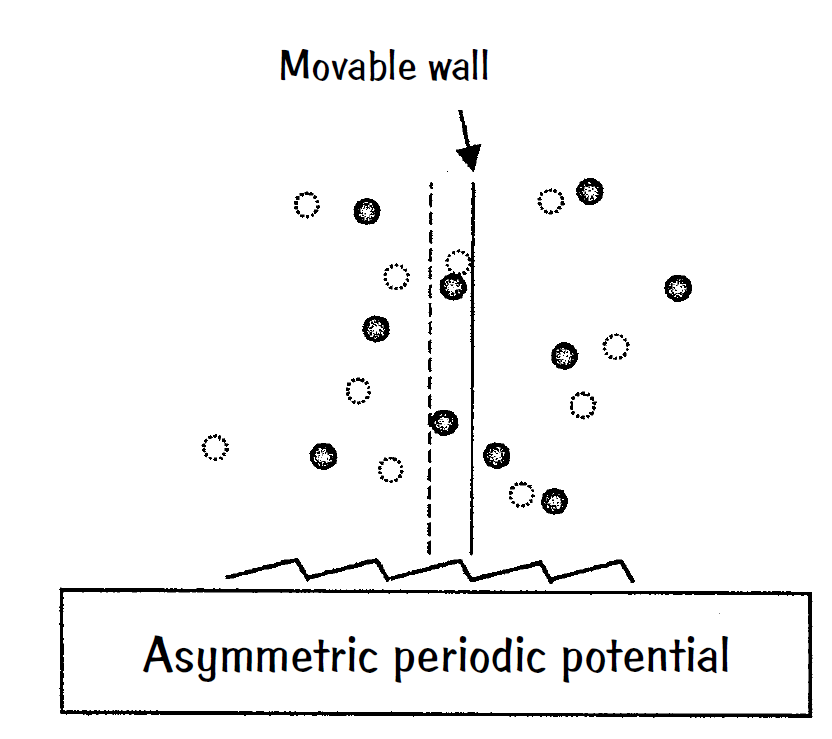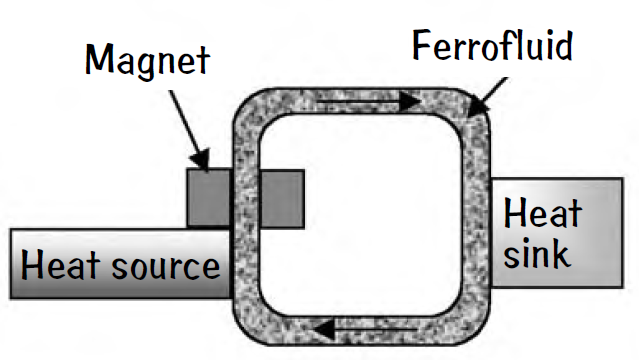
Brownian Motor
 المؤلف:
Franklin Potter and Christopher Jargodzki
المؤلف:
Franklin Potter and Christopher Jargodzki
 المصدر:
Mad about Modern Physics
المصدر:
Mad about Modern Physics
 الجزء والصفحة:
p 50
الجزء والصفحة:
p 50
 18-10-2016
18-10-2016
 490
490
Brownian Motor
In his famous lectures, physicist Richard Feynman discussed the impossibility of violating the second law of thermodynamics by a ratchet mechanism. The simplest model for a ratchet is an over damped Brownian particle in an asymmetric but spatially periodic potential (with asymmetry and period L). Due to the fluctuating force caused by the pushing molecules of the surrounding fluid or gas, the Brownian particle may overcome the potential barrier moving to the left or to the right. The probabilities for both directions are equal, and on average the particle does not move. Hence building a motor that turns thermal energy into mechanical work from a single heat bath is impossible.

But the ratchet can be turned into a so-called Brownian motor that seems to violate the second law of thermodynamics. The idea is to turn the ratchet potential on and off periodically. Under certain circumstances, this action may yield directed motion even against an applied force f. Indeed, this device does work. (No pun intended!)
Recall that a perpetuum mobile of the first kind violates the law of conservation of energy, while a perpetuum mobile of the second kind uses the “free” energy around us in the form of heat that is, random thermal motion of molecules and atoms to run an engine without fuel. Why isn’t a Brownian motor a perpetuum mobile of the second kind?

A ferrofluid is a fluid containing small magnetic particles that respond to an applied magnetic field, so a ferrofluid becomes magnetized in the presence of the magnet. The diagram shows a closed tube loop containing a ferrofluid, a heat source, a strong magnet, and a heat sink all working together to act as an engine transporting the ferrofluid around the closed loop. Its thermal efficiency approaches the efficiency of a Carnot cycle, so demands for this device should increase. Exactly how does this engine maintain the fluid movement around the loop? Can a solar heating system operate in this way?
Answer
As long as the ratchet potential is off, there can be no net movement to the right or the left because the particles will move diffusively according to a (biased) random walk, leading to a variance in position of  and a mean position of <x> = f τ/γ, where D = kT/γ is the diffusion constant. When the ratchet potential is switched on, one or more particles get trapped in one of the potential minima. If αL ≥ δx ≥ (1 – α)L for the variance holds, the particle on average gets trapped into the minimum left of the starting point. The maximum flux is obtained if the switching time t is large enough to assure that the particle can adjust in the trapping minimum (adiabatic adjustment time) and also is small enough to fulfill the above requirement for the variance. Roughly, one can say that a net flux to the left always occurs when thermal energy is significantly smaller than the potential maximum, the external force chosen is not too big, and the driving frequency matches the adiabatic adjustment time needed for the particle to move into a potential minimum.
and a mean position of <x> = f τ/γ, where D = kT/γ is the diffusion constant. When the ratchet potential is switched on, one or more particles get trapped in one of the potential minima. If αL ≥ δx ≥ (1 – α)L for the variance holds, the particle on average gets trapped into the minimum left of the starting point. The maximum flux is obtained if the switching time t is large enough to assure that the particle can adjust in the trapping minimum (adiabatic adjustment time) and also is small enough to fulfill the above requirement for the variance. Roughly, one can say that a net flux to the left always occurs when thermal energy is significantly smaller than the potential maximum, the external force chosen is not too big, and the driving frequency matches the adiabatic adjustment time needed for the particle to move into a potential minimum.
Where does the energy come from leading to a drift against the external force? The energy does not come from the heat bath but from the ratchet potential when it is switched on. At that moment the potential energy o the particle will suddenly be increased. In a simulation, this can be seen by a sudden increase of the energy. But most of the energy pushed into the system will just be dissipated into the heat bath due to the relaxation of the particle into a potential minimum. Only a tiny portion will be used for doing work. Thus a Brownian motor does not violate any law of thermodynamics because it only turns one type of work into another one. Nevertheless, the fluctuating force due to the heat bath is essential for a Brownian motor.
For more details and possible applications in biology and chemistry read the following review articles. For a simulation, there are Java applets on the Internet.
 الاكثر قراءة في طرائف الفيزياء
الاكثر قراءة في طرائف الفيزياء
 اخر الاخبار
اخر الاخبار
اخبار العتبة العباسية المقدسة


